Get Energy-Smart With Loop: If You Measure It, You Can Control it
Do you measure how much energy you’re using at home? If you don't, then you won't know which energy-saving changes will make the biggest impact. Measuring and monitoring your usage is key to saving money on your bill.
If you’re paying for energy on a fixed direct debit, it can be especially hard to know exactly what it’s costing you before the bill comes, and by that point, it’s too late to make a change.
Simply seeing how much energy is costing you can help you use less. It’s called the “feedback effect”. That together with behaviour change driven by insights, household comparisons, and best practice advice has helped Loop households cut their electricity bill by 16% and their gas by 10% on average.
Not only is that a world-leading efficiency saving that means around £250 off your bills, but it also equates to a carbon reduction of 310kg CO2e per year for an average dual-fuel household!
Keeping a close eye on your usage as you incur costs will help you avoid bill shock, and that’s where Loop, the free energy-saving app for your smart meter, can help!
Wasted energy makes up 30% of the average energy bill - do something about it! Get more from your smart meter with Loop.
Sharpen your Energy Instinct
Your Energy Instinct is your ability to instinctively know the most energy-efficient way of doing something and being able to assess whether something is expensive to run. Understanding how your home uses energy enables you to zero in on the most energy-efficient way of doing something.
It takes a bit of training but it accelerates you from an Energy-Saving Novice to an Energy Expert. Every time you open the free Loop app and see how much energy you're using, it's sharpening this instinct.
Your Energy-Efficient Day
Monitoring your energy usage doesn’t have to be difficult or time-consuming. Once you know what normal is for your home, you can develop some good habits to cut your consumption.
Here’s how you can use the Loop app throughout the day to keep in control of your usage.
Morning
You wake up and before you do anything, you put the kettle on, making sure to only fill it with the amount of water you need. You know that overfilling could cost you £12 over the year.
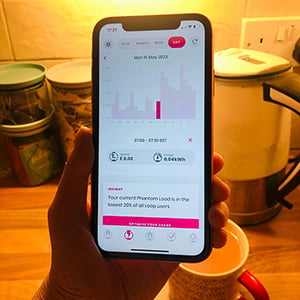
After a quick 5-minute shower in eco mode, you decide that using your hairdryer is necessary today. This 10-minute blow dry will equate to around £16 per year if you were to use a hairdryer every other day.
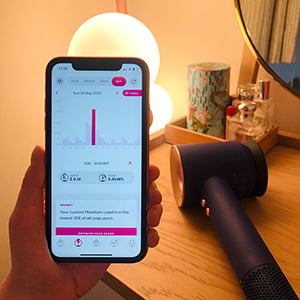
Then, you find out your dishwasher wasn't turned on the night before. You check that it’s a full load and remember to use the eco setting so it will use less power to heat the water. You turn it on, feeling good that it uses less energy than washing dishes by hand.
Using your dishwasher will cause a significant spike in electricity consumption, contributing to 8% of your electricity bill. On average, one load uses around 1.5 kWh. Running it overnight will be greener as the grid is less carbon-intensive and if you have a time-of-use tariff, it would be cheaper too.
➡️ Go to Track view by tapping on the lightning icon at the bottom of the screen and bring your energy use to life! How much does your morning routine add to your energy bill? Tap on ‘Day’ to find out.
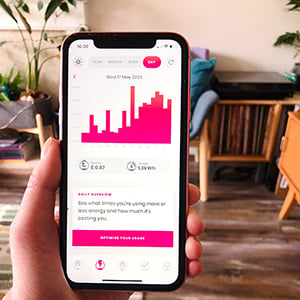
How do you see your energy usage in the Loop app?
- Create your Loop account here.
- Once you’re up and running, go to ‘Track’ by tapping on the lightning icon at the bottom of the screen and select ‘Day’ at the top of the screen.
- Here you’ll be able to see your electricity usage by the half hour. To view a half-hour interval, click on one of the bars on the graph. Below the graph, you will see your consumption in spend (£) and usage (kWh).
Note: Don’t be confused by the graph and usage numbers which appear different. The graph measures in kW, the rate of electricity you use, and the usage summary measures in kWh, the amount of electricity you use. With each usage block shown in half an hour sections, the number for kW will be double those for kWh. - Track back your energy usage over Days, Weeks, Months, and Years by clicking through the buttons at the top of the screen. Switch over to Gas by tapping the flame icon at the bottom of the screen.
Afternoon
Today is one of your work-from-home days. You know you could be using 25% more electricity throughout the day than when you’re in the office. So, once you’ve finished, you’re quick to turn off your monitors and laptop charger at the plug.
These appliances left plugged in contribute to your Phantom Load, our name for the electricity used by appliances switched on or on standby, quietly using energy without you realising. It also applies to the things you know are on but don’t know what they’re costing - like smart speakers, and the things you switch on and forget about - like extra fridges.
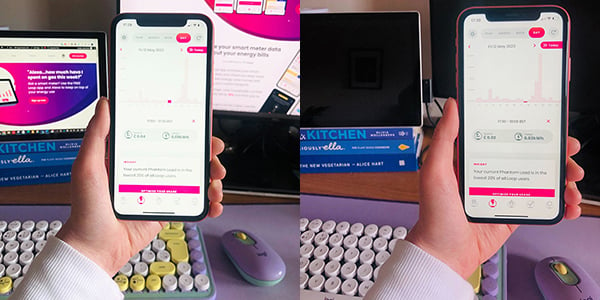
Wasted electricity makes up around 30% of the average electricity bill. Identifying and rethinking how you use these appliances is a simple way to save energy.
➡️ Slay the Phantom! Tap on the Tick icon at the bottom of the screen and tap on ‘Optimise your Phantom Load’. See what wasted energy is costing you and the ways to cut it.
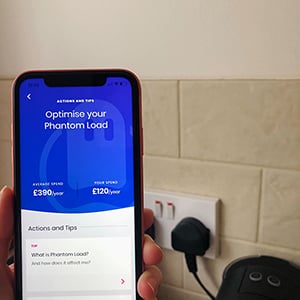
Evening
You’re ready to start making dinner. You avoid the electric cooker as you know this can cost around £97 a year to run and choose your air fryer. This is the quicker and cheaper alternative. Your air fryer costs just 15p to run for 20 minutes. However, an electric oven would cost around 52p.
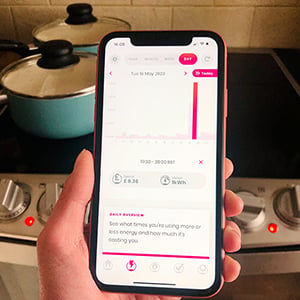
Then, after your long day, you sit down in front of the TV. Being mindful of your Phantom Load, you switch it off at the wall when you’re done watching. With modern electronics, the amount you’ll save by turning off your TV box is small in comparison to big energy stealers that are left on all the time, either intentionally or accidentally. But, it all adds up and this change alone could save you just over £40 on your yearly bill.
Time to go to bed…don’t forget to turn the lights off! Lighting makes up 11% of a typical electricity bill. You’ve already swapped all your lightbulbs to super-efficient LEDs, so you feel good that you’re using 90% less energy than traditional bulbs.
As you’re going upstairs, you glance at your smart meter in-home display to check you’re at your baseline usage and there isn’t anything on that doesn’t need to be.
➡️ Have you swapped to LEDs yet? See what you can save with our calculator. Simply tap the Tick icon at the bottom of the screen and tap on ‘Optimise your Appliances’.

Weekend
You’re spending the weekend at home, tackling lots of household chores during the day and an evening of socialising with friends.
Tasks such as cleaning the dust off your radiators, and defrosting your freezer, are great to improve the efficiency of your appliances. However, when it comes to vacuuming, doing the laundry, and mowing the lawn, you keep an eye on your usage - these big energy-hungry appliances can add up.
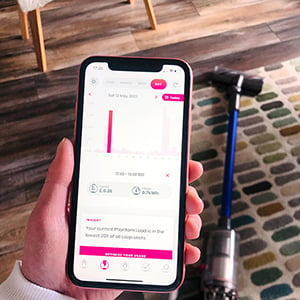
Whilst you know you can’t avoid using these appliances, you make some simple changes to the way you use them, starting by using your vacuum and washing machine on their eco modes to minimise the amount of energy they need to use. You also wash your clothes at 30 degrees which uses 40% less energy than at higher temperatures and you wait until having a full load to run. You then swap the tumble dryer in favour of the clothesline to benefit from the natural warmth of the sun. Using a vented or condenser tumble dryer could add around £500 a year to your bill.
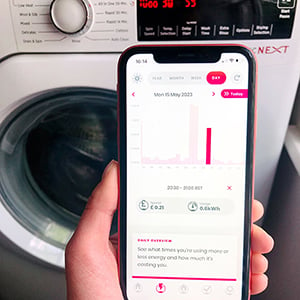
Although you can’t do much to improve the efficiency of mowing the lawn, or other similar non-discretionary tasks, just understanding what this is costing you helps you judge the impact it will have on your monthly bill. Not only will it give you the awareness to make informed decisions about how you use them, but it will also help you to avoid bill shock at the end of the month.
Now it’s time to relax and socialise. Making the most of the sunny day, it’s time to use the hot tub! You know that even the most energy-efficient hot tub can set you back £221 a year, so you’ve placed it in an area of your garden away from the wind to help maintain a warmer temperature. You’ve also been keeping it covered with a thermal cover.
Want to see how much each appliance costs you? Go on a Loop Snoop!
Using your smart meter’s in-home display to get real-time readings, follow the steps below to see the running cost of your things.
- Find out your home’s baseline energy usage by turning off all your appliances (apart from your fridge, freezer, and any other essential appliances) so you have the lowest possible ‘background’ energy use in your home.
- Use your smart meter’s in-home display to see live electricity use. You can toggle between £/hr and live electricity consumption in Watts. Make a note of this background energy usage in £/hr.
- Now go around your home, room by room, turning appliances on and off, one at a time. As you turn each one on, you will see your live £/hr cost change on your smart meter’s in-home display.
- Do some simple maths to reveal the cost of having that appliance turned on for one hour. Record this on your Loop Snoop map here as a reminder to turn stuff off!
➡️ Look over your household’s energy usage over the last week on the Loop app. What days and times did you spend the most? Which changes could you make that would cut your consumption?
• • •
Cut Your Energy Bill With Loop
Loop is a FREE energy-saving app that links to your smart meter, analyses your energy use and shows you easy ways to save. On average, Loop users cut their energy use by 15%! How much could you save?



.png)




